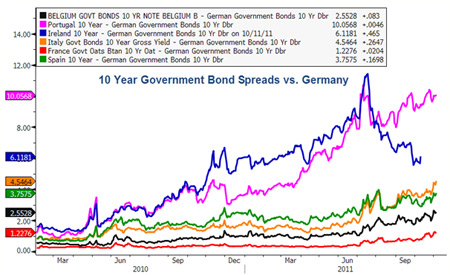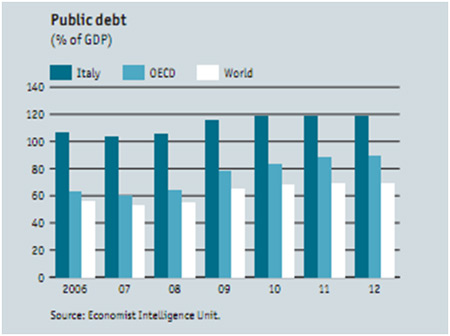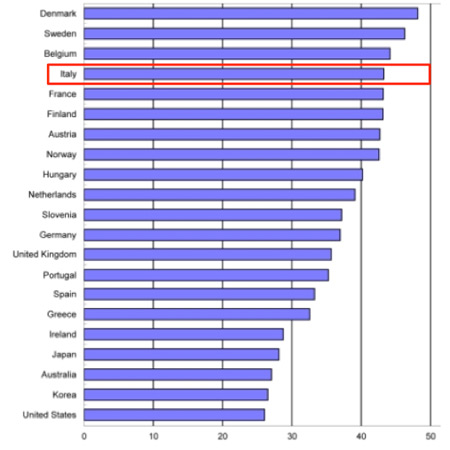The recent economic developments in Europe are not unlike those that confronted investors in late 2007 and early 2008. With investment banks collapsing in the US, the substantial interest rate cuts by the Federal Reserve and the pending resetting of teaser rate subprime mortgages, there was enough evidence to suggest that investors should have been concerned about developments.
How these developments would then translate into pricing movements on the Australian share market was a little more obtuse. However, none of those developments could possibly be interpreted as positive. Thus, those investors that did lift cash levels or maintained cash were well positioned to benefit from the substantial price falls of 2008/09. Those who didn’t raise cash and maintained exposures are to this day still attempting to recoup their losses.
Thus, it is incumbent upon investors to maintain a close watch and understanding of the economic developments in Europe as they do have the potential to send markets into a tailspin.
Specifically, there have been some substantial moves in the yields of European bonds and this is a situation that deserves close attention. Over the last six months, the bonds of Greece, Ireland and Portugal have all devalued against the German bond despite them being issued and traded in Euros. But these are small countries. In the last two weeks, the bonds of Italy (a member of the G8) have slumped with their yields lifting to five per cent above that of a German bond. This is clearly a more significant situation.
Understanding and noting bond yields is important as the bond yield is the so-called ‘risk free rate of return’. If risk free rates rise then it is a confronting development for the assessment of value of other assets.

Remarkably, Italy has had a substantial debt to GDP ratio for many years and debt markets ignored the risk that this presented to lenders. A high debt to GDP ratio exposes lenders when there is an economic downturn and that is exactly what presents itself in Europe right now.
Italy’s 10-year notes traded above 5.5 per cent for 40 days before breaching the six per cent mark on 28 Oct and closed just below seven per cent. Greece, Ireland and Portugal followed a similar trajectory, consistently averaging above six per cent for about a month before crossing the 6.5 per cent barrier. After that, it took an average of 16 days for yields to pass the unsustainable seven per cent level. Portugal and Ireland had to seek bailouts after their yields rose to over seven per cent.
The following simple example gives us an insight into the immense problems confronting Italy.

Source: Economist Intelligence Unit
Let’s assume that we translate Italy’s economy to the following. It has GDP of $100 and net sovereign debt of $120. That is it has a debt-to-GDP ratio of 120 per cent. (That is where Italy stands today).
A review of the tax collection to GDP of most developed economies suggests it could sit at around 40 per cent for a fully employed economy. Australia has a legislated cap on revenue of about 23 per cent of GDP (and we think we are highly taxed!) but let’s assume Italy sustains its government revenue at 40 per cent of GDP.

Source: OECD Charts 2009/10
Despite its level of debt, Italy paid (on average) only about three per cent interest on its debt of $120 in the year 2010. Therefore, across its debt maturities (one month to say 10 years) it was paying $3.60 of interest. Thus, the revenue collected exceeded interest by over 10 times and this is akin to an interest cover ratio. Further, the interest bill approximated Italy’s fiscal deficit of four per cent of GDP. In other words, Italy was borrowing to pay interest. This is why its debt has lifted by over 10 per cent (against GDP) in the last three years.
Following the troubles in Ireland, Portugal and the collapse of Greece the credit markets are being forced to reassess risk. With 120 per cent debt to GDP, the assessed risk of an Italian default has lifted. This in itself has lifted interest costs to Italy from about three per cent to well above six per cent. Over time, Italy’s cost of funding its debt will rise as it issues new debt and rolls maturing debt. Last night the yield on new issue one year Italian paper rose to above seven per cent. Italy clearly has no capacity to redeem debt.
Based on the above, we see that the cost of servicing Italian debt has risen to over $7 per annum. On the assumption that tax revenue is maintained at 40 per cent of GDP (or $40) then the revenue to interest ratio drops to under six times. The increase in interest cost is $3 per annum and unless expenditure is cut then the Italian fiscal deficit will rise to seven per cent of GDP. This deficit is funded by more borrowings and debt will increase again.
As you can see, the country could enter a debt spiral due to rising interest rates and costs. Once it commences, it becomes difficult to stop. If say interest rates rise above 10 per cent (as in Greece) then default becomes probable rather than possible and the Government will be forced to substantially cut expenditure. This in itself causes more economic hardship and stymies economic growth.
Italy now sits at the precipice. Its debt to GDP is over 120 per cent, its unemployment is eight per cent and its fiscal deficit is rising in the face of austerity promises. With the market reassessing the required yield on its bonds, it has become the first G8 country to face rapidly rising costs of sovereign debt.
What does this mean for countries such as France, the United Kingdom, Germany and the United States? Each of these countries have sovereign debt to GDP over 80 per cent and each has its ten-year bonds trading at yields between two to 2.5 per cent.
Clearly Greece is a sideshow compared to the risks associated with the Italian economy and the economic response of European Leaders will have to be swift and significant. One obvious response is for Germany to consent to the European Central bank to print Euros. This quantitative easing would steady bond markets and give European governments time to implement much needed policy changes. It may even give Europeans time to dismiss and replace their leaders with people who can meet the difficulties through a capacity to “think anew and act anew” (quote from Abraham Lincoln, December 1862).













